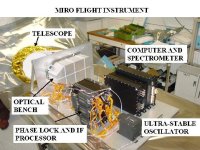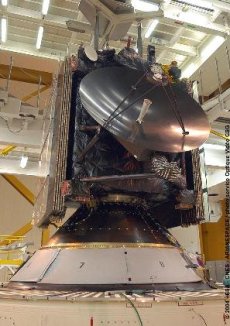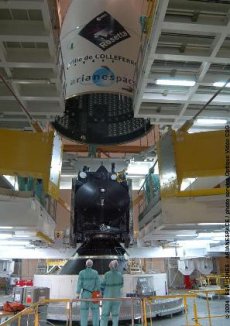
The Paris observatory took part in the Rosetta experiment by : the spectro-imager in the visible and infrared VIRTIS. The LESIA has provided the high spectral resolution component of VIRTIS, see more details the development of the instrument MIRO, which is described below, one "IDS" (Interdisciplinary Scientist"), Marcello Fulchignoni, on the observations of asteroids by Rosetta co-I on the camera OSIRIS MIRO : This instrument is provided by NASA (PI S.Gulkis, JPL), in collaboration with France (Paris and Bordeaux Observatories) and Germany (MPAe). It corresponds to a microwave radiometer-spectrometer with 2 channels (one in millimetre - 190 GHz - and the other submillimeter - 560 GHz) connected to a spectrometer at very high resolution (45 kHz). It aims at measuring abundances of the principal volatile components and a certain number of key isotopic ratios, in order to allow the global characterization of the layer just below the surface of the nucleus (penetration of a few centimetres), as well as the study of the processes controlling sublimation on the nucleus surface and the formation of the internal coma. Thanks to its asset, France (CoI/ project leader G. Beaudin, with the technical team J.M. Krieg, M. Gheudin and A. Deschamps from LERMA, and the scientific team, N. Biver, D. Bockelée-Morvan, J. Crovisier, T. Encrenaz, and E. Lellouch from LESIA, and P. Encrenaz, from LERMA) took part in the instrument concept, in its development (quasi-optics and optimization of the mixer) as well as in the tests and calibrations. The LERMA was also requested to provide the Ultra-Stable Oscillator (stability 2.10-9 over the total duration of the mission, i.e. more than 12 years).
MIRO : This instrument is provided by NASA (PI S.Gulkis, JPL), in collaboration with France (Paris and Bordeaux Observatories) and Germany (MPAe). It corresponds to a microwave radiometer-spectrometer with 2 channels (one in millimetre - 190 GHz - and the other submillimeter - 560 GHz) connected to a spectrometer at very high resolution (45 kHz). It aims at measuring abundances of the principal volatile components and a certain number of key isotopic ratios, in order to allow the global characterization of the layer just below the surface of the nucleus (penetration of a few centimetres), as well as the study of the processes controlling sublimation on the nucleus surface and the formation of the internal coma. Thanks to its asset, France (CoI/ project leader G. Beaudin, with the technical team J.M. Krieg, M. Gheudin and A. Deschamps from LERMA, and the scientific team, N. Biver, D. Bockelée-Morvan, J. Crovisier, T. Encrenaz, and E. Lellouch from LESIA, and P. Encrenaz, from LERMA) took part in the instrument concept, in its development (quasi-optics and optimization of the mixer) as well as in the tests and calibrations. The LERMA was also requested to provide the Ultra-Stable Oscillator (stability 2.10-9 over the total duration of the mission, i.e. more than 12 years).


